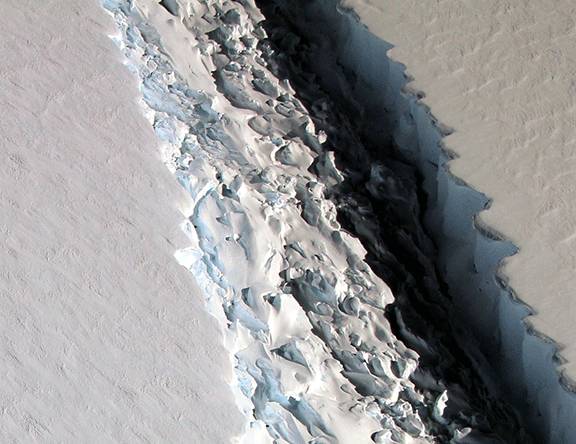We’re on Thin Ice Entering 2017
As we enter the New Year we are on thin ice, figuratively and literally. 2016 was a record breaking year as I will describe in a moment. However, let’s start with the big news this week from the Larsen C ice shelf in Antarctica. The crack or rift that suddenly appeared to get much larger just two months ago, has extended again, as illustrated here. Now more than a hundred miles in length (200 km) — just over ten miles (20 km) remain to complete the separation. When that section breaks off, likely in the next month or two, it will be one of the top ten icebergs ever identified— larger in size than the State of Delaware.
As the detailed image below from NASA shows, the rift is quite dramatic, over a thousand feet deep. New research shows it emanated deep down and much farther inland on the ice shelf, likely resulting from changes over the last couple of years, further evidence of truly seismic changes in this part of Antarctica.

Rift in Larsen C Ice Shelf, Antarctic Peninsula. November 2016. NASA image
The collapse of these ice shelves does not affect sea level directly, since they are mostly floating ice in huge bays along the shoreline. Rising sea level is the result of the melting ice on land — primarily Greenland and Antarctica — as well as the expansion of seawater as it warms, plus some localized effects. But those large ice shelves like Larsen act like stoppers in a bottle, holding back the massive glaciers on land. It is when those glaciers slide into the sea that sea level will rise foot, by foot, by foot. In February I will be at Larsen C on an expedition and expect to have more to report. (If you are not already on my blog mailing list, you can sign up for the latest news in the Subscribe Box on the blog page.)
Looking back over 2016 there was more ominous news, particularly in the far north at the other side of our planet, where another area of melting sea ice sends us a big message and deserves attention. As the Arctic Ocean goes from being frozen for millions of years to becoming increasingly ice free, weather patterns are changing all over the globe. Melting of the Arctic sea ice has a direct effect on atmospheric currents like the Jet Stream, and oceanic currents like the Gulf Stream and the Pacific El Nino. We see that evidenced all over as “normal” weather changes to abnormal: strange storm patterns, record wildfires, droughts, even record amounts of rainfall and cold weather. While most will look back at 2016 and see a year of political upheaval in the US and Europe, it is worth noting the major changes to weather patterns that happened too. Last year there were record fires from California to Gatlinburg now clearly associated with generally warmer temperatures and drier forests. We also witnessed record floods including West Virginia, Maryland, the Carolinas, and Texas. There were plenty of examples of catastrophic fire and floods outside the US too. As we look back on 2016, the scientific findings are rather clear.
2016 marked another year of record high temperature, particularly in the high northern latitudes, where the abnormal warming was about twice the global average. Just two weeks ago, in the week before Christmas, temperatures near the North Pole reached a full 50 degrees Fahrenheit (nearly 30 degrees Celsius) above normal! This NASA time lapse video simulates their best composite of how temperatures have changed over the last century.
All around the Arctic from Alaska, Canada, Scandinavia, and Russia the evidence is unmistakeable. Nowhere more so than in Greenland which I visited in August and November. The evidence of abnormal warming temperature and melting ice is hard to miss as I shared in a number of blog posts at the time, e.g. Greenland is Getting Greener, and even a tale of the military dogsled patrol that could not go out because the ice was too thin.
In fact, there is so much news on the scientific front and in the media that I have decided 2017 is the year to start a new effort, a NEWS page on my website with a continuing digest of the latest articles on sea level rise, each with a short synopsis. I will send it out freely to all my subscribers each week as the Sea Level Rise Now Newsletter. When I do a blog post or article, it will be included in the Newsletter as the lead article, to give readers just a single weekly email from me.
One prediction for 2017 that I can safely make is that the planet will continue to warm, ice sheets will continue to melt, and global sea level will continue to rise. With good information, we can rise with the tide.

